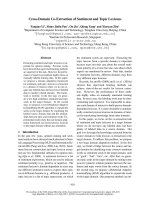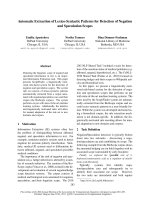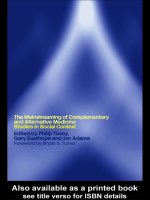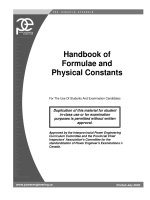Liquid-Delivery Metal-Organic Chemical Vapour Deposition of Perovskites and Perovskite-Like Compounds pdf
Bạn đang xem bản rút gọn của tài liệu. Xem và tải ngay bản đầy đủ của tài liệu tại đây (12.81 MB, 150 trang )
Chemie
Dis
sertation
Liquid-Delivery Metal-Organic Chemical
Vapour Deposition of Perovskites and
Perovskite-Like Compounds
zur Erlangung des akademischen Grades
doctor rerum naturalium
(Dr. rer. nat.)
Mathematisch-Naturwissenschaftlichen Fakultät I
der Humboldt-Universität zu Berlin
Frau M. Sc. Rasuole Lukose
Dekan: Prof. Dr. Andreas Herrmann
Gutachter: 1. Prof. Dr. Erhard Kemnitz
2. Prof. Dr. Roberto Fornari
3. Prof. Dr. Anjana Devi
eingereicht: 26.07.2010
Datum der Promotion: 09.09.2010
1
Selbstständigkeitserklärung
Hiermit erkläre ich, das ich die vorliegende Dissertation selbständig angefertigt habe
und nur die angegebenen Quellen und Hilfsmittel verwendet habe.
(Datum, Ort) Rasuole Lukose
2
Acknowledgments
I wish to express my sincere gratitude to my research supervisor Prof. Dr. Roberto
Fornari, for providing me the opportunity to make my PhD at the Leibniz-Institute for Crystal
Growth, for his support throughout this work and his helpful suggestions in reviewing this
thesis.
My special thanks go to Prof. Dr. Erhard Kemnitz at Humboldt University for accepting
my candidature as a PhD student and for the assistance at the University.
I equally express my gratitude to the leader of the oxide layers group, Dr. Jutta
Schwarzkopf, who directly supervised this work. I am thankful for the support in every aspect
of the experimental work, comprehensive and useful discussions.
I am also very grateful to my colleague Dr. Günter Wagner not only for the helpful
conversations in scientific field but as well as for his help in daily life. I would like to express
my gratitude to group colleagues, Sebastian Markschies and Dr. Saud Bin Anooz for the nice
working atmosphere and for the fact that I could always rely on their assistance.
I would like to express my gratitude to Jr. Prof. Dr. Anjana Devi for the effective
collaboration in the field of metal-organic precursors that were applied in this particular work.
In this context, I would like to thank also all the PhD students of her group, especially Daniela
Beckerman and Ke Xu, for the thermoanalytic measurements of metal-organic precursors.
I would like to thank sincerely to my colleagues at IKZ, especially PD Dr. habil. Martin
Schmidbauer for his help and advices concerning High Resolution X-ray Diffraction
measurements and Albert Kwasniewski for performing these measurements. I am grateful to
Dr. Klaus Irmscher for the discussions on electrical results, Mike Pietsch for performing these
measurements and Dr. Martin Albrecht for the support in characterization with Scanning
Electron Microscopy and Transmission Electron Microscopy. In this context, I would like to
thank Dr. habil. Detlef Klimm and Steffen Ganschow for their help performing some
measurements of the metal-organic precursors. My special thanks go to Dr. Reinhard Uecker
for the supply of the substrates and useful discussions about oxide materials.
I also want to thank the colleagues from the Department of Physics in Humboldt
University, namely Jens Lienemann, Dr. Marco Busch and Prof. Dr. Helmut Winter for the
fruitful collaboration and AES measurements.
Additionally, I would like to thank Dr. Andrea Harrer, Carsten Hartmann, Dr. Tobias
Schulz, Dr. Daniela Gogova for the friendly and encouraging atmosphere at work and also
outside the Institute.
3
My specials thanks go to my colleagues at Faculty of Chemistry in Vilnius University,
especially Dr. Valentina Plausinaitiene for the scientific discussions and support.
Last but not the least; I express huge thanks to my family: my husband, my mother and
my sister for their support, encouragement and trust in me during all these study years.
4
Abstract
Perovskites and perovskite-like materials are actually of great interest since they offer a
wide range of structural and physical properties giving the opportunity to employ these
materials for different applications.
Liquid-Delivery Metal Organic Chemical Vapour deposition (LD-MOCVD) was chosen
due to the easy composition control for ternary oxides, high uniformity and good conformal
step coverage. Additionally, it allows growing the films, containing elements, for which only
solid or low vapour pressure precursors, having mainly thermal stability problems over long
heating periods, are available.
The purpose of this work was to grow SrRuO
3
, Bi
4
Ti
3
O
12
and (Na, Bi)
4
Ti
3
O
12
films by
LD-MOCVD and to investigate the influence of the deposition conditions on the properties of
the films. Additionally, the effect of the strain due to the lattice mismatch between substrates
and films on the physical properties of the films was also investigated.
SrRuO
3
films were grown on stepped SrTiO
3
(001), NdGaO
3
(110) and DyScO
3
(110)
substrates, which were prepared under different conditions by changing the annealing time
and atmosphere. The termination of the substrates was measured by surface sensitive proton-
induced Auger Electron Spectroscopy (p-AES) technique.
Another systematic study of the relation between epitaxial strain and Curie temperature
of thin SrRuO
3
(100) films was performed by using substrates with different lattice constants.
The observed Curie temperature decreased with compressive and increased with tensile strain.
Thin films of Bi
4
Ti
3
O
12
as well as (Na, Bi)
4
Ti
3
O
12
were successfully deposited. In order
to grow stoichiometric and epitaxial Bi
4
Ti
3
O
12
(001) films, Bi excess in the precursor solution
was necessary, due to the volatility of Bi. Substitution of Bi with Na in Bi
4
Ti
3
O
12
was
achieved for the first time for the films deposited by LD-MOCVD.
Perovskites, LD-MOCVD, oxide substrates, thin films, strain.
5
Zusammenfassung
Perowskite und Perowskit-artige Materialien sind von großem Interesse, da sie eine
Vielzahl von strukturellen und physikalischen Eigenschaften haben, welche die Möglichkeit
bieten, sie für unterschiedliche Anwendungen einzusetzen.
Die Methode der Liquid-Delivery Metal Organic Chemical Vapour Deposition (LD-
MOCVD) wurde gewählt, da sie eine gute Kontrolle über die Zusammensetzung ternärer
Oxide und eine hohe Homogenität der Filme ermöglicht. Darüber hinaus können mit dieser
Methode Filme hergestellt werden, die aus Elementen bestehen, für welche nur feste
Precursor oder welche mit niedrigem Dampfdruck zur Verfügung stehen.
Ziel dieser Arbeit war es, mit Hilfe der LD-MOCVD Filme aus SrRuO
3
, Bi
4
Ti
3
O
12
und
(Na,Bi)
4
Ti
3
O
12
abzuscheiden und den Einfluss der Wachstumsbedingungen auf die
Eigenschaften der Filme zu untersuchen. Zusätzlich wurde die Wirkung der Verspannung, die
durch die Gitterfehlanpassung zwischen Substrat und Film entsteht, auf die physikalischen
Eigenschaften der Schichten untersucht.
SrRuO
3
Filme wurden auf gestuften SrTiO
3
(001), NdGaO
3
(110) und DyScO
3
(110)
Substraten gewachsen, deren Oberflächenterminierung durch oberflächensensitive Proton-
induzierte Auger-Elektronen-Spektroskopie (AES) bestimmt wurde. Die Substrate wurden
unter verschiedenen Bedingungen durch Änderung der Temperdauer und -atmosphäre
präpariert.
Die systematische Untersuchung der Beziehung zwischen Verspannung und Curie-
Temperatur von dünnen SrRuO
3
(100) Filmen erfolgte unter Verwendung von Substraten mit
unterschiedlichen Gitterkonstanten. Die beobachtete Curie-Temperatur sank mit erhöhter
kompressiver Verspannung und nahm mit erhöhter tensiler Verspannung zu.
Um stöchiometrische und epitaktische Bi
4
Ti
3
O
12
(001) Filme zu wachsen, war aufgrund
der Flüchtigkeit des Bismuts ein Bi Überschuss in der Precursor-Lösung notwendig. Die
Substitution von Bi durch Na in Bi
4
Ti
3
O
12
wurde zum ersten Mal in LD-MOCVD-Filmen
erreicht.
Perowskite, LD-MOCVD, oxidische Substrate, dünne Filme, Verspannung.
6
Table of contents
Selbstständigkeitserklärung 1
Acknowledgments 2
Abstract 4
Zusammenfassung 5
Table of contents 6
List of Abbreviations 8
Introduction 9
1. Fundamentals 11
1.1 Perovskites and their structural properties 11
1.2 Epitaxial growth 12
1.2.1 Misfit strain 13
1.2.2 Growth modes 14
1.3 Ferroelectrics and ferromagnets 17
1.4 Magnetic and electric properties of perovskites and perovskite-like materials 19
1.4.1 Ferromagnetic – metallic SrRuO
3
19
1.4.2 Curie temperature dependence on different effects of SrRuO
3
21
1.4.3 Electrical resistivity of thin SrRuO
3
films 23
1.4.4 Ferroelectric - dielectric Bi
4
Ti
3
O
12
25
2. Experimental techniques 28
2.1. Vertical liquid-delivery metal-organic chemical vapour deposition technique 28
2.2 High resolution X-ray diffraction 33
2.3 Auger electron spectroscopy 36
2.4 X-ray photoelectron spectroscopy 38
2.5 Atomic force microscopy 39
2.6 Scanning electron microscopy 41
2.7 Raman spectroscopy 44
2.8 Electrical measurements 45
2.9 Electron impact mass spectrometry 47
2.10 Thermoanalytic methods 48
2.10.1 Principle of TG-DTA and TG-DSC analysis methods 48
2.10.2 Isothermal TG studies 50
2.10.3 Heating stage microscope 50
7
3.
Experimental results and discussion 51
3.1 Vicinal surfaces of cubic and orthorhombic substrates 51
3.1.1 General remarks 51
3.1.2 Preparation and properties of vicinal substrate surfaces 52
3.1.2.1 SrTiO
3
(001) 53
3.1.2.2 NdGaO
3
(110) 56
3.1.2.3 DyScO
3
(110) 60
3.2 Chemistry of metal-organic precursors 67
3.2.1 Precursor requirements for MOCVD 67
3.2.2 Available precursors for metal oxides 71
3.2.3 Thermal and mass spectrometry analysis of precursors used for the deposition of
SrRuO
3
, Bi
4
Ti
3
O
12
and (Na, Bi)Ti
4
O
12
films 73
3.2.3.1 [Na(thd)] 75
3.2.3.2 [NaTMSA] 78
3.2.3.3 [Bi(thd)
3
] 81
3.2.3.4 [Ti(O
i
Pr)
2
(thd)
2
] 83
3.2.3.5 [Sr(thd)
2
tetraglyme] 86
3.2.3.6 [Ru(thd)
3
] 89
3.3 Deposition of epitaxial SrRuO
3
films 92
3.3.1 Control of SrRuO
3
film composition 92
3.3.2 Surface morphology of SrRuO
3
films in dependence of deposition temperature, time
and supersaturation 101
3.3.3 Strain engineering of SrRuO
3
electrical properties 108
3.4 Deposition of epitaxial Bi
4
Ti
3
O
12
films 114
3.5 Na substitution at Bi site in epitaxial Bi
4
Ti
3
O
12
films 122
4. Conclusions 133 .
List of p
ublications 137
References 138
8
List of Abbreviations
AES – Auger Electron Spectroscopy
AFM – Atomic Force Microscopy
CVD – Chemical Vapour Deposition
DSC – Differential Scanning Calorimetry
DTA – Differential Thermal Analysis
ε
⊥
– epitaxial strain
e-AES – electron-induced Auger Electron Spectroscopy
EI-MS – Electron Impact Mass Spectrometry
FWHM – Full Width of Half Maximum
XRF – X-ray Fluorescence Analysis
HRXRD – High Resolution X-ray Diffraction
LD-MOCVD – Liquid-Delivery Metal-Organic Chemical Vapour Deposition
LSAT – (LaAlO
3
)
0.3
– (Sr
2
AlTaO
6
)
0.7
MBE – Molecular Beam Epitaxy
ML – Monolayer
O
i
Pr - isopropoxide
p-AES – proton-induced Auger electron Spectroscopy
PLD – Physical Layer Deposition
R
a
– average roughness
RHEED – Reflexion High Energy Electron Diffraction
RMS – Root mean square
SEM – Scanning Electron Microscopy
θ
B
– Bragg angle
T
c
– Curie temperature
TEM – Transmission Electron Microscopy
TG – Thermogravimetry
thd – 2,2,6,6-tetramethyl-3,5-heptanedione
UHV – Ultra High Vacuum
XPS – X-ray Photoelectron Spectroscopy
Introduction
9
Introduction
Perovskites and perovskite-like materials are very interesting materials because they
offer a wide range of structural and physical properties. They are very well known for their
common structural instabilities which can be caused by temperature, pressure, strain or partial
substitution by different cations. These instabilities cause not only changes in structure, but
also in physical properties like Curie temperature, spontaneous polarization, dielectric
constant, fatigue, which are important for the application of such materials in non-volatile
random access memories, high dielectric constant capacitors and optical waveguides.
In order to measure the electrical properties of the ferroelectric thin layers, one
possibility is to sandwich the ferroelectric between two electrodes to form a capacitor. The
properties of these capacitors depend on stoichiometry, phase composition, morphology and
microstructure of both the electrode and ferroelectric film, as well as on the structural and
electronic character of the electrode-ferroelectric interfaces. Two main groups of the
electrodes are used to form metal-ferroelectric-metal capacitors: single metals (Pt, Au, Ru)
and metallic oxides (RuO
2
, IrO
2
, SrRuO
3
).
In addition, the properties of the heterostructure also depend strongly on the interface
between substrate and electrode. The initial growth of electrode films actually depends on the
surface morphology and termination layer of the substrate. Therefore, in the present work
vicinal SrTiO
3
, NdGaO
3
and DyScO
3
substrates were prepared under different preparation
conditions before the deposition of thin epitaxial SrRuO
3
films. The terminating surface layer
of the substrates was determined by proton-induced Auger electron spectroscopy in order to
investigate the status of the interface between the substrate and epitaxial layer.
In the present study metallic-ferromagnetic SrRuO
3
was chosen as a model system for
possible bottom electrode, which was grown on perovskite substrates, therefore it may serve
as an epitaxial template with a proper crystallographic orientation for the epitaxial growth of
ferroelectric films. SrRuO
3
was selected because it is chemically stable and has a structural
similarity to most perovskite substrates and thin films and has a good electrical conductivity.
Additionally, strained thin SrRuO
3
films showed a clear behaviour of the Curie temperature
depending on the strain caused by using different oxide substrates which is interesting for
fundamental and practical studies and only marginally studied so far.
However, growth conditions like deposition temperature and pressure, supersaturation,
gas phase composition, post annealing conditions etc. determines the growth mode of thin
Introduction
10
films as well. The liquid-delivery MOCVD was used for the growth of epitaxial perovskite
and perovskite-like layers because it offers excellent film uniformity, and good conformal
step coverage. Additionally, it allows growing the films, containing elements, for which only
solid or low vapour pressure precursors, having thermal stability problems during
transportation, are available. In LD-MOCVD these problems are solved by dissolving
precursors in a liquid solvent and transporting them as a liquid to a flash evaporator with the
help of carrier gas. In addition, by using this method, the stoichiometry of the films can be
easily controlled.
The main goal of this thesis was to grow ferromagnetic-metallic SrRuO
3
and
ferroelectric Bi
4
Ti
3
O
12
, (Na, Bi)
4
Ti
3
O
12
thin films in order to get single phase epitaxial layers
and to investigate the fundamental properties of the films depending on deposition conditions.
To this extent, the structural and physical properties of the films depending on different oxide
substrates (SrTiO
3
, NdGaO
3
, DyScO
3
) inducing epitaxial strain in thin layers were
investigated and used as feedback for the definition of optimized growth parameters.
The thesis is organized as follows: Chapter 1 describes the general structural and
physical properties of the investigated perovskite and perovskite-related materials. The
mismatch between the film and substrate and its effect on the properties of the epitaxial thin
film is also presented in this chapter.
The growth method and characterization techniques used to investigate the properties of
SrRuO
3
, Bi
4
Ti
3
O
12
and (Na, Bi)
4
Ti
3
O
12
films are summarized in Chapter 2.
The detailed discussion of the experimental results can be found in Chapter 3. In
Section 3.1 the preparation process and conditions of atomically flat SrTiO
3
(001),
DyScO
3
(110) and NdGaO
3
(110) surfaces and the measurement of the termination layer of the
surfaces are described in detail. In Section 3.2 special attention has been paid to the physical
and chemical properties of metal-organic precursors used for deposition of the layers with
liquid-delivery MOCVD. A study of SrRuO
3
layers in terms of the surface morphology, phase
composition, epitaxial strain and Curie temperature is presented in Section 3.3. The
deposition results of layered Bi
4
Ti
3
O
12
films are summarized in Section 3.4. Section 3.5 deals
with the deposition results and structural properties of A-site substituted (Na, Bi)
4
Ti
3
O
12
layers. In the last chapter (Chapter 4) general conclusions of the work are summarized.
1. Fundamentals
11
1. Fundamentals
1.1 Perovskites and their structural properties
Perovskite and perovskite-like materials are interesting due to diverse physical and
chemical properties in a wide range of temperature. For example, perovskites are known for
their superconducting properties ((K,Ba)BiO
3
) [1], piezoelectric properties (Pb(Zr,Ti)O
3
) [2]
relaxor ferroelectric properties (Pb(Nb,Mg)O
3
) [3], (Na,Bi)TiO
3
) [4], dielectric properties
(BaTiO
3
[5]
,
SrTiO
3
[6]), conductive-ferroelectric (SrRuO
3
) [7], electro-optic properties
((Pb,La)(Zr,Ti)O
3
) [8], magneto-resistive properties ((La, Ca)MnO
3
) [9] and catalytic
properties (LaCrO
3
) [10].
The ideal perovskite structure ABO
3
belongs to the cubic crystal structure and consists
of a three-dimensional framework of corner sharing BO
6
octahedron, where big A cations are
coordinated with 12 equidistant oxygen anions and relatively small B cations are in the
middle of these octahedral (Fig. 1.1 a).
Fig. 1.1 Perovskite-type structures: a) ideal cubic perovskite, b) perovskite with tilted BO
6
octahedra, c) layered-perovskite structure with two perovskite blocks.
According to Lufaso and Woodward [11], most perovskite structures are distorted and do not
have an ideal cubic symmetry. Common distortions such as cation displacements within the
1. Fundamentals
12
BO
6
octahedra and tilting of the octahedra are related to the properties of the A and B
substituted atoms. Factors that contribute to distortion in the structure include radius size
effect and bond length between the cations and oxygen. Such octahedral tilting distortions
(Fig. 1.1. b), present in many perovskites, is related to the stability of the perovskite structure
and is described by the so called ‘tolerance factor’ t which was introduced by Goldschmidt in
early 1920s [12]:
(
)
( ) ( )
,
22 OB
OA
rr
rr
OB
OA
t
+
+
≡
−
−
≡
Eq. 1.1
where r
A
, r
B
and r
O
are the ionic radii of cation A, B and anion O, (A-O) and (B-O) the bond
length between the cations and oxygen, respectively. Geometrically, for an ideal perovskite, if
the bond length is roughly assumed to be the sum of the two ionic radii, the t-value of the
ideal perovskite should be equal to 1. When the value of t is 0.81 or less and the radius of the
A site ion is smaller than ideal, the BO
6
octahedra will tilt in order to fill the space. Stable
perovskite structures have values approximately in the 0.78 < t < 1.05 range. The distortions
result in bending of the B–O–B bridges which reduces the strength of B–B interactions (e.g.
magnetic exchange coupling, transfer or hopping integral, width of the energy bands) so that
the critical temperatures for ordering phenomena (e.g. magnetic, superconducting and
ferroelectric) usually decrease as t falls. Even a small structural distortions which can be
driven by parameters like temperature, pressure, strain, external electric and magnetic fields,
etc., may change significantly the physical properties of the perovskites.
Another class of perovskite-related compounds is provided by the so-called layered
perovskites (Fig. 1.1 c), where the perovskite blocks (A
m-1
B
m
O
3m+1
)
2-
are separated by A-site
cation oxide (Bi
2
O
2
)
2+
in the case of Bi-layered compounds. The Bi – layered perovskite
compounds are one of the best candidates for the lead-free non-volatile ferroelectric memories
due to their promising ferroelectric properties, where the cation substitution at A and B sites
helps to improve the ferroelectric properties necessary for memory applications [13,14]. There
is a big interest in these materials, from an environmental point of view also, because there is
a need for the preparation of a new generation of efficient lead-free ferroelectrics.
1.2 Epitaxial growth
Epitaxy is commonly defined as the oriented growth of a crystalline material on a single
crystal surface. Epitaxial growth is classified in: a) homoepitaxy - when film and substrate
1. Fundamentals
13
consist of the same material, and b) heteroepitaxy - when they are different. The present work
will concern only heteroepitaxial growth. In the ideal case, epitaxy proceeds as so-called
pseudomorphic growth with the substrate lattice continuing in the thin film. It is evident that
the continuation of the substrate crystal lattice will be associated with the incorporation of
strain into the layer when the layer and substrate unit cells are different [15] up to the critical
thickness of the film.
1.2.1 Misfit strain
Enormous strains can exist in thin films when one material is deposited onto another
[16], resulting from differences in crystal lattice parameters and thermal expansion behaviour
between the film and the underlying substrate or arising from defects formed during film
deposition [17,18]. As a result, the properties of thin films can be evidently different than the
intrinsic properties of the corresponding unstrained bulk materials [7,19,20,21]. Right
selection of substrates, growth parameters and strain, offers the opportunity to enhance
particular properties of a chosen material in thin film form, which is called strain engineering.
It was observed that the resulting strain induces large shifts in the ferroelectric-to-paraelectric
transition temperature (T
c
) and remnant polarization for ferroelectric materials [22,23,24].
The difference of lattice parameters between substrate and layer plays a very important
role for film stress and defect density. The driving force for film relaxation increases with
strain and film thickness. When films are grown to thicknesses greatly exceeding their critical
values, relaxation toward a zero strain state by the introduction of dislocations begins. Thus,
for strain engineering to be effective, it is important to grow films below, or at least close to,
their critical thickness for relaxation. If the mismatch between the film and substrate is large,
the critical thickness can be only few atomic layers, while for a small mismatch in may reach
hundreds of nanometers. To avoid dislocations in the thin films it is necessary to select a
small mismatch (∆a/a) between thin film and substrate, which is defined by (Eq. 1.2):
100%
f s
s
a a
a
a a
−
∆
= × Eq. 1.2
where a
f
and a
s
are the bulk lattice constants of the film and the substrate, respectively [21].
Depending on the choice of substrate, films may be grown under compressive or tensile
strain. When the lattice constant of the substrate is smaller than the one of the layer, the layer
will be compressively strained (the cell is elongated in the out-of-plane direction and
1. Fundamentals
14
compressed in-plane). Whereas a larger lattice of the substrate leads to the tensile strain in the
layer (the cell is compressed in out-of-plane direction and elongated in-plane) (Fig. 1.2).
Strain energy accumulates rapidly with film thickness resulting in misfit dislocation
generation or morphological transformation from 2D layer-by-layer to 3D island growth.
Which of these mechanisms is operative depends on the quality and termination of the
substrate surface (see Section 3.1) and on the kinetics of the film growth, depending on the
deposition conditions.
SrTiO
3
DyScO
3
Compressive
strain
Tensile strain
SrRuO
3
SrRuO
3
Fig. 1.2 Schematic drawings of the lattice cell distortion of strained epitaxial SrRuO
3
.
1.2.2 Growth modes
For heteroepitaxy in general, three growth modes are observed depending on three main
parameters: the supply of the material to the reaction zone, the deposition temperature and
mismatch between the film and the substrate, resulting in different film morphologies [25]. In
this section, for the description of the growth modes the effect of mismatch will be taken into
account. These main growth modes are a) the layer-by-layer (Frank-van der Merwe) growth,
e.g., in the case of a very thin layer, or in the case of almost perfectly lattice-matched
materials; b) the layer-then-island (Stranski-Krastanov) growth, an intermediate growth mode,
where a layer grows below a critical thickness and subsequently 3D island growth occurs, and
c) the island (Volmer-Weber) growth, mainly for (highly) lattice-mismatched materials
(Fig. 1.3).
1. Fundamentals
15
Layer - by - layer
Layer - then - island
Island growth
Fig. 1.3 The main heteroepitaxial growth modes.
The interface between the substrate and the film is very important especially at the
beginning of the growth. The structure of the interface, and its properties, depend essentially
on four parameters: a) the misfit between the substrate and the layer, b) the thickness of the
film, c) the strength of the interaction between the substrate surface and the first atomic layers
of the deposited film, d) the surface quality of the substrate.
The strain resulting from lattice mismatch contributes to the interface energy, a key
parameter in determining the growth mode. However, the surface free energies of the
substrate and film materials also influence the mode of growth. Bauer and van der Merwe
[26] have cast the energetics of film growth into a particularly simple form under the
assumption of equilibrium between the film components in the gas phase and those at the film
surface. In this formalism, layer-by-layer growth requires that:
0
film i subs
γ γ γ γ
∆ = + − ≤
Eq. 1.3
where γ
film
and γ
subs
are the surface free energies of film and substrate, respectively, and γ
i
the
free energy of the interface. The latter quantity depends on the strain and the strength of
chemical interactions between atoms of the film and substrate at the interface. The equation
says that the sum of the film surface energy and the interface energy must be less than the
surface energy of the substrate (γ
subs
> γ
film
+ γ
i
) in order layer-by-layer growth to occur, which
becomes easier as the surface energy of the substrate increases. However, the strain energy
(γ
i
), increases linearly with the number of strained layers. At some thickness, γ
film
+ γ
i
exceed
γ
subs
and the growth mode transforms from layer-by-layer to island growth resulting in 3D
islands on the 2D layer (layer-then-island growth). Alternatively, γ
film
may be sufficiently in
excess of γ
subs
that the equation is never fulfilled even for a strong attractive interaction
between the atoms of the layer and substrate and little strain (γ
i
<0). In this case, 3D island
nucleation occurs [27].
1. Fundamentals
16
Additionally, the growth mode of the films depends largely on the surface morphology,
termination and lattice mismatch of the substrate. Therefore, controlling the surface
morphology and chemistry of the substrates is very important for the reproducibility of the
grown layers. The control the surface morphology and chemistry of the substrate is possible
by applying surface treatments such as annealing or chemical etching of the substrate. It has
been found that single crystal SrTiO
3
substrate cutted at a vicinal angle and annealed in
oxygen [28] produce a periodic step-and-terrace pattern with mixed SrO and TiO
2
termination
layers on the substrate surface. Chemical etching and following high temperature annealing of
the SrTiO
3
substrates produces uniform steps of single unit cell height with a purely TiO
2
terminated surface [29,30]. The terraced surface, which results from these surface treatments,
offers a reproducible surface template to reduce the number of domains in the grown films.
The substrate surface step density, overall substrate morphology, and surface adatom
diffusivity also effect the growth on stepped surfaces. If the diffusion length of adatom is
longer compared to the mean terrace width on the surface, adatom condensation will occur
preferentially at steps rather than on terraces. Step-flow growth is a specialized case in which
there is preferential adatom attachment from lower terraces adjacent to steps (Fig. 1.4). Step-
flow leads to step-step annihilation and a gradual reduction in step density if the step-flow is
disturbed. At lower temperatures, adatom diffusivities are lower leading to enhanced
condensation on terraces. If the distribution of adatoms on the terraces is 2D, a periodic
change in step density occurs as growth proceeds if the temperature is high enough, otherwise
3D growth can occur. Also if the step density is too low (i.e. width of the terraces is too
large), then 2D island nucleation is more likely on terraces and not at the step edges.
Fig. 1.4 Sequence of incorporation of atoms on the stepped substrate surfaces [31]. I)
adsorption of adatom on the surface, II) surface diffusion, III) migration of adatom to a kink
site on the terrace.
1. Fundamentals
17
1.3 Ferroelectrics and ferromagnets
In this section the general similarities and differences between the ferroelectric and
ferromagnetic materials and the reasons causing these processes will be shortly described,
because this thesis will focus mainly on two different materials: ferromagnetic SrRuO
3
and
ferroelectric Bi
4
Ti
3
O
12
.
There are indeed many similarities between the ferroelectrics and ferromagnets. The
ferroelectrics can be defined as materials with spontaneous permanent electrical polarization
switchable by the external electric field. Likewise, a ferromagnet has a spontaneous
permanent magnetic polarization which changes the orientation with application of an
external magnetic field. Usually the switching process between two equivalent states is
associated with the hysteresis, which has a very similar form in both cases (Fig. 1.5 and
Fig. 1.6).
Fig. 1.5 Switching between two equivalent ferroelectric states under applied electric field and
resulting polarization hysteresis. Coercive field is the electric field required for bringing the
internal polarization to 0.
For both material classes the hysteresis is characterized by the three quantities: remnant
polarization (residual magnetization) is the measured polarization (magnetization) in absence
of an external electric (magnetic) filed, saturated polarization (magnetization) is the state
reached when an increase in applied external electric (magnetic) field can not increase the
polarization (magnetization) of the material further, and the coercive filed is defined as
1. Fundamentals
18
electric (magnetic) field, which is required to reduce the polarization (magnetization) to zero
after the polarization (magnetization) of the sample has been driven to saturation.
Of course, the reasons of ferromagnetism and ferroelectricity are quite distinct;
ferroelectrics have an asymmetry in charge, whereas ferromagnets have an asymmetry in
electronic spin. A ferroelectric material exhibits a spontaneous electrical polarization
1
if a
non-centrosymmetric arrangement of the constituent ions and their corresponding electrons
occur. Off symmetry is not sufficient for ferroelectricity, the electrical polarization must in
addition be switchable and a transition between two stable states of opposite polarization must
be accessible. The non-centrosymmetric structure is reached by shifting either the A or B
cations (or both) from the center relative to the oxygen anions, and the spontaneous
polarization derives largely from the electric dipole moment created by this shift. This
property is exploited for non-volatile ferroelectric random accesses memories [32].
Ferromagnetism occurs due to completely different reasons: while a ferroelectric
requires off center displacements of the cations, in a ferromagnet the constituent electrons
must have a net angular magnetic momentum.
Fig. 1.6 Switching between two equivalent ferromagnetic states under applied magnetic field
and resulting polarization hysteresis.
1
Electric polarization that a ferroelectric possesses in the absence of an external electric field. The maximum
value of remnant polarization is a spontaneous polarization, having specific value for the material at the given
temperature.
1. Fundamentals
19
This can arise from either the orbital component of the angular momentum or the spin
component (if there are unequal numbers of the up- and down-spin electrons) or both. By
applying a magnetic field the random orientated magnetic domains are ordered in the
direction of the magnetic field. Potential applications of ferromagnetic films are magnetic
memory devices [33].
Both the ferromagnetic and ferroelectric polarization decreases with increasing
temperature, with a transition to an unpolarized (paramagnetic or paraelectric) state occurring
at Curie temperature. Above Curie temperature for ferromagnets there are equal numbers of
up- and down-spin electrons, and hence no magnetic moment. Below Curie temperature the
up- and down-spins are unequally populated by electrons, leading to a net magnetic moment.
Here the analogy with ferroelectricity can be found, where Curie temperature is coincident
with off-centring of the ions, causing the net polarization below Curie temperature.
1.4 Magnetic and electric properties of perovskites and
perovskite-like materials
1.4.1 Ferromagnetic – metallic SrRuO
3
SrRuO
3
is a metallic conductive oxide that crystallizes in an orthorhombic perovskite-
type structure with the lattice parameters of a = 5.538 Å, b = 5.573 Å, and c = 7.856 Å at
room temperature [34] (Fig. 1.1 b). Because of the small structural distortions (rotations and
tilts) in the RuO
6
octahedron, the crystal structure of SrRuO
3
can be regarded as a pseudo-
cubic structure (Fig. 1.7) with a lattice parameter of a
c
= 3.93 Å.
1. Fundamentals
20
Fig. 1.7 The general view of the orthorhombic elementary cell and selection of pseudo-cubic
ABO
3
structure (structure with octahedral inside). Big open circles represent A-site atoms,
filled circles represent B-site atoms and small open circles represent oxygen atoms. O(1)
stands for the apical oxygens in the BO
6
octahedra along the [110] crystallographic direction
and O(2) represents the oxygens in the (110) plane.
Thin films of SrRuO
3
have attracted considerable interest due to their low room
temperature resistivity of about 280 µΩ·cm (bulk) [35] and a small lattice mismatch with a
range of functional oxide materials such as Bi
4-x
La
x
Ti
4
O
12
[36], SrBi
2
Ta
2
O
9
[37], BiFeO
3
[20],
Pb(Zr
x
Ti
1-x
)O
3
[38]. Furthermore, ferroelectric capacitors fabricated from epitaxial
SrRuO
3
/Pb(Zr
x
Ti
1-x
)O
3
/SrRuO
3
heterostructures grown on miscut SrTiO
3
substrates have
demonstrated significantly improved fatigue
2
behaviours when the oxide/oxide interface has
replaced the traditional oxide/platinum interface [39,40,41]. This improvement in fatigue
behaviour is partly attributed to improved electrode-ferroelectric interfaces, due to similarities
in crystal structure of the electrode and ferroelectric layer. Therefore SrRuO
3
is one of the
most suitable conductive oxides used as a bottom electrode in a thin film form for a variety of
ferroelectric and multiferroic thin film heterostructures.
2
Decrease of remnant polarization with repeated switching of polarization.
1. Fundamentals
21
1.4.2 Curie temperature dependence on different effects of SrRuO
3
SrRuO
3
is the only known ferromagnetic oxide of 4d transition metals with a Curie
temperature of about 160 K [42]. In SrRuO
3
the interaction between two transition metal
(Ru) cations is through the oxygen atom (Ru-O-Ru), where p orbitals of the oxygen hybridize
with d orbitals of Ru, leading to p-d orbital hybridization. The magnetic state of SrRuO
3
is
very fragile and depends critically on the overlapping of Ru 4d and O 2p orbitals, which is the
main reason of ferromagnetism in this compound. Since the ferromagnetic interaction in
SrRuO
3
appear when α is close to 180° (163° [43] for orthorombically distorted SrRuO
3
),
where α stands for Ru-O-Ru bonding angle. Therefore structural changes are known to lead to
a shift of the Curie temperature (T
c
). There are three main effects resulting in a structural
change of SrRuO
3
; a) substitution of Sr with cations of different atomic radius, b) non-
stoichiometry of Ru, c) induced strain in the layers, when mismatched substrates are used. In
all these cases the change of Curie temperature can be explained by the structural changes in
the films involving Ru-O-Ru bonding angle in RuO
6
octahedron.
Concerning (a) case Jin et al. [43] published the structural differences in three ruthenium
oxides (ARuO
3
, A = Ca
2+
, Sr
2+
, Ba
2+
). The ferromagnetic properties in these oxides are
different mainly due to the different Ru-O-Ru bending angles and origin of the A-site cation.
Replacement of Sr
2+
with Ba
2+
leads to lower T
c
(60 K), however as BaRuO
3
is a cubic
perovskite the maximal interaction between neighbouring Ru
4+
ions appear and it should lead
to higher T
c
as for SrRuO
3
(Table 1.1). In the case of CaRuO
3
the highest structural distortions
occur, therefore the interaction between neighbouring Ru ions is suppressed and CaRuO
3
is
paramagnetic. The changes in the Curie temperature depend not only on the structural
changes in ARuO
3
crystal structure, but also on the ionic nature of the cation substituted in A-
site, therefore such big differences in the ferromagnetic properties in CaRuO
3,
SrRuO
3
,
BaRuO
3
appear.
Table 1.1 Structural and ferromagnetic differences of ARuO
3
perovskites.
Ionic radius <r
A
>, Å Ru-O-Ru angle, °
Structure Curie temperature, K
CaRuO
3
Ca
2+
= 1.34
148.6
orthorhombic
paramagnetic
SrRuO
3
Sr
2+
= 1.44
163.1
orthorhombic
ferromagnetic (160)
BaRuO
3
Ba
2+
= 1.61
180
cubic
ferromagnetic (60)
1. Fundamentals
22
(b) Ru deficiency: Dabrowski et al.
[44] showed that at certain preparation conditions
Ru deficient compounds SrRu
1-υ
O
3
can be formed with randomly distributed vacancies at Ru
sites. The bond angle between the Ru ions connected via apical oxygen increases with the
increase of Ru vacancies leading to the increase of lattice volume (Table 1.2) and decrease of
Curie temperature. Similar results are expected if oxygen vacancies are present in the
structure.
Table 1.2 Structural and magnetic properties of SrRu
1-υ
O
3
compounds [45].
Ru
deficiency, υ
Lattice volume,
V [Å
3
]
Ru–O
apical
-Ru angle, ° Curie Temperature,
T
c
[K]
0 240.85 162.94 163
0.02 241.05 163.49 135
0.09 241.53 164.60 82
(c) Thin films epitaxially grown on the mismatched substrates, thinner than the critical
film thickness will be strained to match the lattice of the substrate. However, when the film
thickness exceeds the critical thickness value, the layer relaxes by introducing misfit
dislocations [46]. With the relaxation of the structure, an increase of the electrical resistivity
(Fig. 1.8. b) and a shift of the Curie temperature from 160 K for a strain-free to 150 K for a
compressively strained SrRuO
3
film grown on SrTiO
3
by off-axis sputtering was noticed [7]
(Fig. 1.8 a and b).
Fig. 1.8 a) Magnetization, b) and resistivity dependence on temperature of strained and strain-
free SrRuO
3
films [7].
Terai et al. [47] also noticed a change of the Curie temperature in the 160 K to 164 K
range for SrRuO
3
films grown by PLD on SrTiO
3
substrates, where films under tensile strain
exhibited higher Curie temperature than compressively strained or relaxed films. The tensile
1. Fundamentals
23
strain was changed by modifying the composition of the Ba
1-x
Sr
x
TiO
3
/BaTiO
3
buffer layer,
deposited on SrTiO
3
.
1.4.3 Electrical resistivity of thin SrRuO
3
films
The Ru amount in the layers is directly related to the Ru supply and to the oxygen
pressure during the deposition process [48]. In particular, it turns out that Ru off-
stoichiometry can be varied in SrRuO
3
thin films by using different deposition techniques
(PLD, MBE). It seems that until know no reports about Ru deficient films deposited by
chemical vapour deposition technique were published. The deficiency of ruthenium, as well
as deficiency of oxygen changes the electrical properties of the SrRuO
3
. In both cases the Ru
and oxygen vacancies increase the volume of the crystal lattice and alter the average Ru-O-Ru
bond angle. Thus, electron correlation in SrRuO
3
can be reduced or even completely
suppressed [49]. Semiconductor behaviour with higher resistivity compared with
stoichiometric SrRuO
3
occur when the oxygen pressure during the deposition process is
reduced below a certain limit [50] (Fig. 1.9) resulting in oxygen vacancies, whereas high
oxygen pressures leads to Ru deficiency due to probable Ru removal in form of volatile RuO
4
[51].
Fig. 1.9 Resistivity-temperature dependence on oxygen pressure of SrRuO
3
thin films grown
by PLD on SrTiO
3
substrates at 640 °C. The kink in the curve is coincident with
ferromagnetic transition [50].
1. Fundamentals
24
The electronic and magnetic properties of oxides are very sensitive also to film
thickness [52] and the structure of the interface [53] between the layer and substrate. In thin
films, higher resistivity in conducting oxides is commonly found when the film thickness is
decreased from 320 nm to 8 nm, influenced by the interface with the substrates, resulting in
different morphology of the films [54,55]. According to Toyota et al. [56] the critical film
thickness at which metal-insulator transition occurs is 4–6 monolayers (ML), where resistivity
decreases with the film thickness (Fig. 1.10).
Fig. 1.10 Temperature dependence of resistivity for ultrathin SrRuO
3
films with various
nominal film thicknesses [56].
This behaviour can be affected by the microstructural disorder caused by the 3D island
formation at the initial growth stage of ultrathin SrRuO
3
films. Electrical resistivity decreases
with the increase of the smooth area of the 3D islands and finally saturates when the
atomically flat surface appear at 50 ML thickness (Fig. 1.11).
Fig. 1.11 AFM images (scan area 2×2 µm
2
) of ultrathin SrRuO
3
films with nominal film
thicknesses of a) 6 b) 10; c) 20; d) 50 ML [56].









